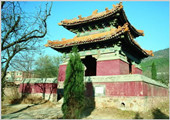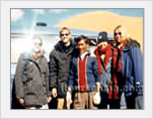
Jingtai Tomb
- Travel to Jingtai Tomb During the Ming, two princes’ tombs were converted into emperors’ tombs. One of them was the Jingtai Tomb. Emperor Daizong (Zhu Qiyu) was the second son of Zhu Zhanji, one year younger than his elder brother Yingzong (Zhu Qizhen). The title of Prince Cheng was conferred during the “Tumubao Battle” by the Wala Tribe of Mongolia. Empress Dowager Sunshi issued an edict to order Zhu Qiyu to handle state affairs. In the ninth month the same year, Yu Qian and other put forth a proposal to Empress Dowager Sunshi. They suggested that the country would be lucky to have a new emperor. With the consent of Empress Dowager Sunshi, Zhu Qiyu ascended the throne and changed the title of the region to the first year of Jingtai. In 1456 (the end of 7th year of Jingtai), Zhu Qiyu was so seriously ill that he could not go to worship the Heaven in the southern suburb. Several days later, he died at the age of thirty at the West Palace. Later in the years of Chenghua, Emperor Xian Zong (Zhu Jianshen) restored the title of Emperor Jingtai to Zhu Qiyu and remade the prince’s tomb of an emperor. A divine kitchen, a divine warehouse, and a tablet house were added. But no precious city or soul tower was added. Nowadays, the Tablet House, the Tomb Gate, the Tomb Wall and the Tomb still remain. In August 1979, the Jingtai Tomb was listed as important cultural relic under the protection of the Beijing Municipal Government.
During the Ming, two princes’ tombs were converted into emperors’ tombs. One of them was the Jingtai Tomb. Emperor Daizong (Zhu Qiyu) was the second son of Zhu Zhanji, one year younger than his elder brother Yingzong (Zhu Qizhen). The title of Prince Cheng was conferred during the “Tumubao Battle” by the Wala Tribe of Mongolia. Empress Dowager Sunshi issued an edict to order Zhu Qiyu to handle state affairs. In the ninth month the same year, Yu Qian and other put forth a proposal to Empress Dowager Sunshi. They suggested that the country would be lucky to have a new emperor. With the consent of Empress Dowager Sunshi, Zhu Qiyu ascended the throne and changed the title of the region to the first year of Jingtai. In 1456 (the end of 7th year of Jingtai), Zhu Qiyu was so seriously ill that he could not go to worship the Heaven in the southern suburb. Several days later, he died at the age of thirty at the West Palace. Later in the years of Chenghua, Emperor Xian Zong (Zhu Jianshen) restored the title of Emperor Jingtai to Zhu Qiyu and remade the prince’s tomb of an emperor. A divine kitchen, a divine warehouse, and a tablet house were added. But no precious city or soul tower was added. Nowadays, the Tablet House, the Tomb Gate, the Tomb Wall and the Tomb still remain. In August 1979, the Jingtai Tomb was listed as important cultural relic under the protection of the Beijing Municipal Government.
Jingtai Tomb Tour
More ToursYour Question & Quick Answer*Design Your Own Trip
Beijing Top Attractions
Beijing Travel Information
Our Service
Booking Procedures | Terms & Conditions | Payment Methods | Links | Site Map | About Us | Contact Us | Travel Agent
Copyright 2008, All rights reserved.. itourbeijing.com professional Beijing tour operator and China travel service
TEL: 86-10-85711972 (Universal) 1-888-288-9328 (North America) E-mail: contact@itourbeijng.com
Tours Index | China Tours | Beijing Tours | Xi'an Tours | Shanghai Tours | Guilin Tours | Tibet Tours
China Travel | Beijing Travel | Shanghai Travel | Xi'an Travel | Guilin Travel |The Great Wall Tours
China Golf | Beijing Golf | Shanghai Golf | Xiamen Golf | Beijing Map | Beijing Side Trip | Yangtze Cruise | Travel Picture



